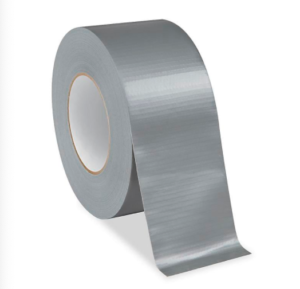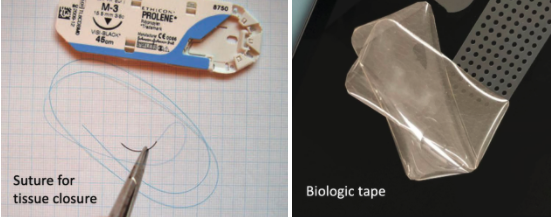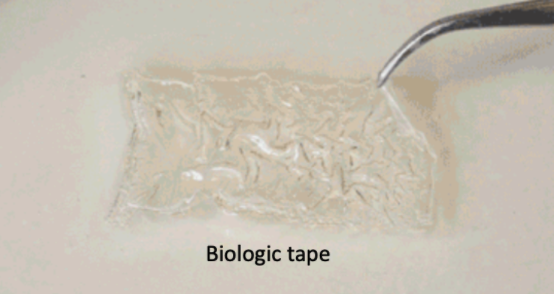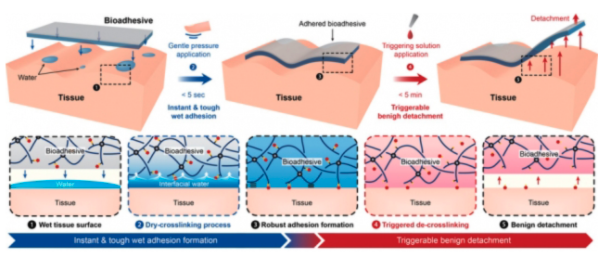 The ubiquitous ability of duct tape to fix anything has been common knowledge since World War II. It was originally made of cotton duck fabric (not from real ducks) and repelled water like a duck’s feathers, so it nicely fits its moniker. Duct tape was easy to apply and remove by hand, making it extraordinarily useful for packaging ammunition in sealed boxes during the war, but also for the common man at home.
The ubiquitous ability of duct tape to fix anything has been common knowledge since World War II. It was originally made of cotton duck fabric (not from real ducks) and repelled water like a duck’s feathers, so it nicely fits its moniker. Duct tape was easy to apply and remove by hand, making it extraordinarily useful for packaging ammunition in sealed boxes during the war, but also for the common man at home.
 During surgery, we often encounter the need to bind tissues together. Suture only works so well. In neurosurgery specifically, there are many applications for biological fixation. If a surgeon enters the ventricles of the brain, which contain cerebrospinal fluid (CSF), there is a risk of developing hydrocephalus requiring future procedures like shunts. There is debate if it’s indicated, and it may be difficult to primarily reclose the ventricle.
During surgery, we often encounter the need to bind tissues together. Suture only works so well. In neurosurgery specifically, there are many applications for biological fixation. If a surgeon enters the ventricles of the brain, which contain cerebrospinal fluid (CSF), there is a risk of developing hydrocephalus requiring future procedures like shunts. There is debate if it’s indicated, and it may be difficult to primarily reclose the ventricle.
 Similarly in repairing the most external coverings of the brain, called the dura, a failed water-tight closure can lead to leakage of fluids and the development of post-surgical infection. In spine surgery, we can also encounter CSF leaks, about 1%-17% of the time, which can result in complications. Even with suture closure, leakage occurs from the needle holes around sutures. In the rare-ish situation in which we need to open the spinal dura, as in resecting a spinal cord tumor or vascular malformation, the spinal cord may become tethered to the dural covering after surgery. What causes this scar tissue tethering is unclear, but maybe reactionary to the sutures.
Similarly in repairing the most external coverings of the brain, called the dura, a failed water-tight closure can lead to leakage of fluids and the development of post-surgical infection. In spine surgery, we can also encounter CSF leaks, about 1%-17% of the time, which can result in complications. Even with suture closure, leakage occurs from the needle holes around sutures. In the rare-ish situation in which we need to open the spinal dura, as in resecting a spinal cord tumor or vascular malformation, the spinal cord may become tethered to the dural covering after surgery. What causes this scar tissue tethering is unclear, but maybe reactionary to the sutures.

Researcher using the biotape to hold himself off the ground
Researchers at MIT developed an adhesive tape that can quickly seal soft and fragile tissues, even when wet. This new tape relies on polyacrylic acid to absorb water from a tissue surface and form a temporary bond. As opposed to a suture, the inner surface of the closure would not expose the neural tissue or CSF to foreign material, potentially decreasing a complicating inflammatory reaction.
Furthermore, like duct tape, this adhesive is very effective at sealing, is water-resistant, and can be applied to the most delicate of issues. It does not appear this tape has yet been applied in neurosurgery, but its potential usefulness is exciting.
 The original version of this adhesive was very potent and strong, unfortunately to the degree that it could not be removed or repositioned without causing significant tissue damage. A newer version allows it to be placed but detached using an antidote if it needs repositioning.
The original version of this adhesive was very potent and strong, unfortunately to the degree that it could not be removed or repositioned without causing significant tissue damage. A newer version allows it to be placed but detached using an antidote if it needs repositioning.
This new surgical “duct tape”, although not called such by the inventors, maybe as innovative and handy as the everyday household version.






